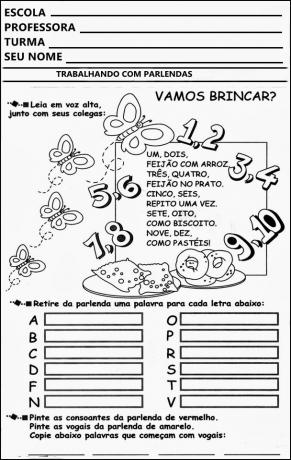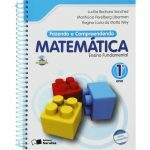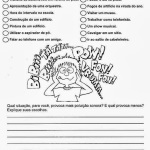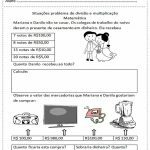
Didactic sequence means a set of pedagogical exercises systematically organized, based on a certain textual genre. They aim to help children master the different textual genres present in our Portuguese language.
Below, we have separated a small corner of the didactic sequences with some example of a didactic sequence, followed by a lesson plan based on it. We hope you enjoy:

Justification:
Parlenda, as a work proposal in the initial literacy classes, attends the student fully, enriching its universe of knowledge and at the same time, it rescues the playful, the pleasurable in the process of learning.
Goals:
· Develop oral and written language in a playful way.
· Identify words and phrases within the memorized text.
Contents: oral and written language.
Year: 1st and 2nd year.
Estimated time: Eight lessons.
Parlenda: The monkey went to the fair.
Material needed:
· Copy of the parlenda in capital letters.
· Text sliced into sentences, words and syllables.
· Colored pencils.
Development:
1st step:
· Contextualize. Let's start a work with parlendas.
Do you know any? I'll recite one that we're going to memorize:
· Recite the speech to the students.
THE MONKEY WENT TO THE FAIR
DID NOT KNOW WHAT TO BUY
BOUGHT A CHAIR
FOR COMADRE TO SIT
COMADRE SAT
THE CHAIR RUBBED
POOR COMADRE
STOPPED IN THE CORRIDOR.
· Repeat a few times for everyone to memorize.
· Divide the class into pairs with productive levels and ask each pair to recite the parlenda to make sure everyone has memorized it.
2nd step: With the class divided into pairs of the following levels of writing.
Pre-syllabic: Undifferentiated and differentiated (IND /DIF). Differentiated and without sound value (DIF /SVS).
Syllabic: No sound value and sound value (SVS /CVS). With alphabetic sound and syllabic value (CVS /S.ALF). Alphabetical syllabic and regular alphabetic (S.ALF. / ALF. REG).
Ask or speak the parlenda so that the teacher can write on the board.
NOTE: Make interventions so that all pairs participate. Socialize with everyone reading slowly and the teacher pointing out the words.
4th step:
Deliver the written text to the pairs and ask them to find some of the words they asked for. Example: The teacher asks the students to search the text for the word FAIR and mark it with colored pencils. Circulate around the room and make interventions appropriate to each level of writing, so that all students can complete the activity.
5th step:
Sliced text.
Deliver the text in strips for students to assemble.
The activity should be developed as follows: The pairs of students from pre-syllabic writing levels IND and DIF and pre-syllabic DIF with SVS syllabic, the text must be delivered in sentence strips and with the help of the bank of Dice.
For SVS and CVS syllabic writing level students the text must be delivered in sentence strips, but without the database.
Student pairs of CVS and S.ALF syllabic writing levels must strips of words first with the help of the database and then without the help of the database. The pairs of students of syllabic writing levels S.ALF and ALF. REG the text must be delivered sliced into syllables ask them to assemble first with the help of the database then without the help of the database. After all pairs have finished putting together their texts, suggest that they read to the teacher.
6th step:
Laccinated.
Deliver the blank text for students to read and identify the missing words. The teacher makes the appropriate interventions at different levels of writing. Now deliver the missing words for students to read and fit in the correct places.
The activity must be developed as follows:
Students of pre-syllabic and syllabic writing levels SVS and CVS need help from the database. Students of CVS and S.ALF syllabic writing levels. S.ALF and ALF.REG. activity can be done without the help of the database.
7th step:
With the parlenda written on the blackboard, ask each pair to go there and read a certain sentence pointing out word for word. The teacher makes interventions so that they can complete the reading.
8th step:
Mobile alphabet.
Ask students to assemble the parlenda using the letters of the mobile alphabet. For students of writing levels pre-syllabic IND and DIF, pre-syllabic DIF and syllabic SVS, syllabic SVS and CVS, the activity must be developed with the help of the database. To students of syllabic writing levels S.ALF AND ALF. REGISTRATION the activity carried out without the database.
Assessment:
During the classes and in the ability of each student to develop the activities
Did you like it? Share this post on your social network
 2 CLASS PLAN SPACE NOTION EARLY CHILDHOOD EDUCATION
2 CLASS PLAN SPACE NOTION EARLY CHILDHOOD EDUCATION
 MAGIC WORDS FOR EARLY CHILDHOOD EDUCATION
MAGIC WORDS FOR EARLY CHILDHOOD EDUCATION
 4 Mathematics Book for Elementary School in PDF – Download
4 Mathematics Book for Elementary School in PDF – Download
 4th grade science activities
4th grade science activities
 ACTIVITY IDEAS ON FINANCIAL MATHEMATICS
ACTIVITY IDEAS ON FINANCIAL MATHEMATICS
 CLASS PLAN VOCAL MEETING
CLASS PLAN VOCAL MEETING
This site uses Akismet to reduce spam. Learn how your comment data is processed.


